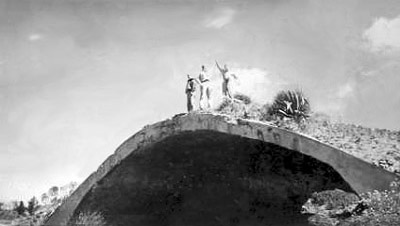On April 1, 1945, Okinawa was invaded. This was the last stepping stone on the road to Japan. Admiral Nimitz was the commander in charge of the Invasion. He knew only too well of the Kamikaze capability and ordered LeMay to destroy as many on the ground as possible.
 UNDERGROUND HANGAR AT OKINAWA. Photo by W. Mayo |
The Marianas were now crowded with over 700 B-29s which were accompanied on missions by hundreds of P-51s. On April 13, 327 B-29s swept over Tokyo at night incinerating eleven square miles. Two nights later 303 Superfortresses were back over Tokyo burning six square miles. Also destroyed was three an a half square miles of the town of Kawasaki, and a mile and a half of Yokohama. Admiral Nimitz ordered Lemay to drop thousands of mines which virtually shut down all shipping. The mine laying left the Japanese in chaos, as the results were so effective Japan was actually starving. Nimitz praised LeMay and called the results phenomenal. On May 11 Nimitz released Lemay from his obligation to take out the Kamikaze after destroying 483 on the ground and 218 in the air. Nimitz would later realize the full fury of the Kamikaze as ship after ship, including carriers, went to the bottom. How was the number of suicide planes miscalculated by such a large amount. There were times when the outcome of the invasion of Okinawa was in doubt, as the Kamikazes attacked with such vengeance.
LeMay, back on the top priority of demolishing Japan, on May 14 sent 472 B-29s loaded with incendiaries bombed Nagoya. Two nights later 457 planes finished off Nagoya and LeMay removed it's name from the list of cities to be bombed. On May 23, 520 B-29s hit Tokyo industrial complex. They were met with blinding searchlights, heavy smoke, heavy flak, and night fighters with orders to ram. This time they were also attacked by the Baka suicide bombs. Seventeen B-29s were lost on this single raid. Another five square miles of Tokyo was burned. Two nights later 502 planes returned, but this night was to be one to remember forever. 26 B-29s were lost and 100 damaged. On the ground another 17 square miles burned, leaving Tokyo over half destroyed. Yokohama was next on the list. The B-29s were protected by P-51s who shot down 26 planes. Despite the excellent fighter cover five B-29s were lost and 175 damaged. Yokohama was mortally wounded with nine square miles burned. LeMay could now concentrate on Japans industrial complex in Osaka, Japans second largest city. This mission also was destined to end in tragedy. 148 Mustangs joined the bombers which soon ran into a weather front with near zero visibility. Planes collided and 27 crashed. Only 27 mustangs of the original 148 joined 458 B-29s to hit Osaka. The Japanese fighter assault was fierce, as they downed five B-29s. Three square miles of Osaka was burned. It was to be a very costly mission. On June 5, 473 B-29s attacked Kobe in daylight with no escort. Four square miles of the industrial complex was destroyed. The losses of B-29s was continuing at a staggering rate, with nine shot down and 176 damaged. Many of the planes could not make it all the way back and either ditched or landed at Iwo Jima.
LeMay was considering rotating his crews after 35 missions. Major Shorty Hull received word his wife had just given birth. Hull was convinced that LeMay would order him to fly more missions, so he demanded to be allowed to fly the Kobe mission. His aircraft was shot down, his crew parachuted and was captured. They were tried for committing war crimes, found guilty and beheaded the same day.
Two more raids hit Osaka on June 7 and 15, burning out another four square miles. The final raids on Osaka ended Bomber Commands plan to incinerate metropolitan Japan. Our cost was monumental in terms of aircraft and crews. LeMay tried to convince Norstad that the B-29 could win the war by continuing the bombing without invading the homeland. He said we could just keep bombing them until they quit. During the summer the Marianas was super crowded with over 1000 B-29s. In June a new outfit named the 509th Composite Group with 15 B-29s was stationed at an isolated area on Tinian. The crewmembers never talked about why they were there, only the Commander Col. Paul Tibbets knew why.
LeMay continued to insist that with his plan the war would be over shortly. He had already paralyzed the entire country, destroying most of the aircraft factories, oil refineries, steel plants, and burned down most of the cities. His next program would be to bomb four cities, Omuta, Hamamatsu, Yokkaichi, and Kagoshima. After that opposition was so light he dropped leaflets in advance not only to save lives but to frighten workers away from their jobs. After observing the almost total devastation, LeMay advised Gen. Arnold that very shortly he would not have any cities left to destroy. Kyoto was off limits because it was a religious and cultural center. LeMay noted that four cities were left - Hiroshima, Nagasaki, Niigata, and Kokura. Of course these cities were reserved for the A-Bomb. The last mission sent 828 B-29s and 186 fighters over Japan without a single loss. On Aug. 6 and 9, 1945, the A-Bombs were dropped, and Japan surrendered unconditionally. Several conflicting reports put our losses of 414 to 512 Bombers, with 576 fliers killed and 2400 missing in action. Training losses in the U.S. were reported to have claimed another 260 B-29s. Our "Road To Victory" was a very costly one.
EPILOGUE
COMMONS, AUGUST 16, 1945
WINSTON S. CHURCHILL
Story by Wayland Mayo. Personal comments by him are his own personal opinion. Wayland is the website historian.